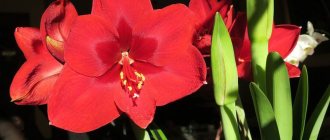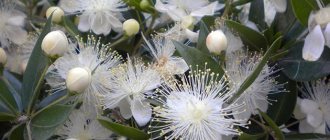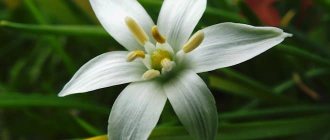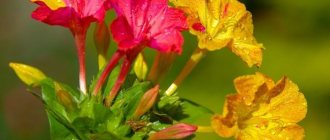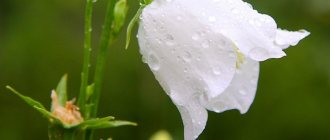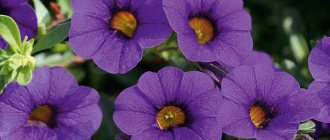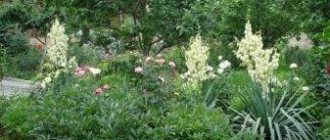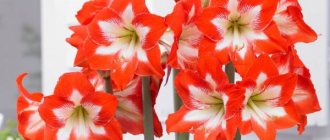Amaryllis care
Amaryllis is rightfully one of the most attractive house plants. It harmoniously combines the grace of leaves, the tenderness of inflorescences and a delicate aroma. At the same time, caring for the plant is so simple that even a novice gardener can grow an exotic guest from Africa.
Homeland and appearance of amaryllis
Amaryllis is native to South Africa. Very often amaryllis are confused with very similar plants - hippeastrum. However, amaryllis is much less common.
You can also add the following to the differences:
- Amaryllis has smaller inflorescences;
- Amaryllis blooms when the plant has leaves;
- Amaryllis can also be grown in open ground.
Amaryllis leaves are long, green, and shaped like a tongue. The length of the leaf plate reaches half a meter, the width is no more than 3 cm. On one plant, the leaves are arranged in two rows.
The bulb is pear-shaped, half visible from the ground. An adult bulb forms several shoots with buds.
The inflorescences consist of 3-11 flowers of different colors, each of which is formed by six petals. The diameter of one flower is from 6 to 10 cm.
Recommendations for caring for amaryllis
Amaryllis belong to the group of unpretentious plants, caring for which will not cause much difficulty even for novice gardeners.
The main thing is to follow a few simple recommendations:
- Provide amaryllis with plenty of light;
- Protect the plant from excess moisture;
- The plant should be planted in small flowerpots;
- Amaryllis need regular feeding, with the exception of the dormant period;
- The juice of the plant is poisonous, so all work with amaryllis should be done with gloves and avoid contact with mucous membranes, skin and eyes.
Irrigation mode and air humidity
Amaryllis should be watered only after the earthen ball has dried out a little. It is advisable to pour water into the tray to avoid contact of the bulb with moisture.
The maximum air humidity for amaryllis is 80%; at higher humidity there is a high probability of developing a fungal disease. During the dormant period, it is necessary to maintain humidity within 50-90%.
Lighting requirements
Amaryllis is a light-loving plant. It requires bright, diffused light. Direct rays of the sun are possible before 11:00 and after 16:00. During the period of active growth, a long daylight hours is required - at least 16 hours.
The optimal place for growing is south-eastern or south-western window sills.
Temperature
Optimal temperature for amaryllis:
- Daytime – from +20 to +22 degrees;
- Night - not lower than +18 degrees.
During the rest period, the temperature can drop to +10 degrees.
Remember that amaryllis does not tolerate sudden changes in temperature, and a drop below zero can cause the death of the flower.
Fertilizer and feeding
Amaryllis needs feeding during the period of active growth. At this time, it is necessary to alternate organic and mineral fertilizers. The frequency of fertilizing is once every few weeks.
Organic fertilizers:
- Bird droppings: 10 grams per bucket of water (10 liters);
- Mullein: 250 grams per bucket of water (10 liters).
Mineral fertilizers are applied to the soil in the following ratio: 3 grams per liter of water.
It should be remembered that excess nitrogen in the soil leads to the development of a red burn on the plant.
Types and varieties of amaryllis with photos
Beautiful amaryllis or belladonna (Amaryllis belladonna)
It was once considered the only type of amaryllis and is still most common in home floriculture. Amaryllis belladonna is distinguished by large bulbs (up to 10 cm in diameter) and tall peduncles (up to 70 cm). The flowers have 6 petals and are often colored in shades of red, pink, lilac or creamy white. The inflorescences have a pleasant smell.
There are more than a hundred varieties of amaryllis, some of which are hybrids with hippeastrum. The most common in floriculture:
- "Durban" ("Durban") - flowers in the shape of a large red bell with a white throat.
- "Snow Queen" is a hybrid with double white flowers with cream edges.
- "Grandior" - variegated white and pink inflorescences with a green throat.
- "Red Lion" is a variety with large bright red flowers.
- 'Minerva' has showy red flowers with a green and white star in the middle.
Indoor plants Flowering indoor plants
Amaryllis transplant
As for the frequency of replanting amaryllis, the opinions of flower growers vary somewhat.
Some recommend replanting the flower once every few years, and some advise changing the flowerpot and soil annually. It is important to understand that transplantation is the most important step in caring for amaryllis. In this way, you can stimulate the flowering of the plant, because a pot that is too spacious or a large number of children on the bulb are the main reasons for the lack of inflorescences.
To properly transplant amaryllis, you must follow some rules:
- The diameter of the flowerpot should be chosen so that the distance between the bulb and the wall of the container does not exceed 3 cm.
- You only need to plant the bulb halfway.
- The best time to transplant amaryllis is July - the time when the plant is preparing to emerge from its dormant period.
- During replanting, it is important to preserve the leaves, as they are a source of nutrition for the young bulb.
- After transplantation, the amaryllis root system is formed within one and a half months.
The acidity of the soil for amaryllis should be in the range of 6.0-6.5 pH.
Soil composition:
- Sod land - two parts;
- Leaf soil - two parts;
- Perlite or sand - two parts;
- Humus is one part.
You can also use an earthen mixture consisting of three parts leaf soil and one part humus.
The soil must be sterilized before use.
Description and basic information
In the photo is Amaryllis belladonna, only botanists reserve full right to be called amaryllis. In everyday life, this beautiful name is also assigned to hippeastrum, so all further information applies to this genus of plants.
The amaryllis bulb shoots one or two arrows during its growth period. The plant loves dry, hot climates and cannot withstand excessive humidity. Periods of growth and flowering alternate with periods of dormancy, when the plant needs low temperatures and a minimum amount of light.
Interesting! In Moscow there is an Amaryllis clinic - the name is associated with positivity and a healthy glow.
Amaryllis propagation
Propagation of amaryllis by seeds
To form seeds, pollen must be transferred from the stamens to the stigma of another inflorescence. Seed ripening occurs over the course of a month at a temperature no higher than +24 degrees. Double pollination significantly increases the efficiency of seed ripening. Amaryllis can self-pollinate. As soon as the seed pods begin to crack, you can collect planting material. Seed germination lasts for six weeks. That is why it is recommended to sow seeds immediately after collecting them.
For better germination, the following substrate is used:
- Leaf soil - two parts;
- Sod land - one part;
- Humus is one part.
The seed planting depth is 0.5 cm. The soil mixture must be kept moist at a temperature of +22 to +25 degrees.
After the formation of two leaves, the plants are transplanted into separate pots. It is important to take into account that varietal characteristics are not preserved when propagated by seeds. For the first few years, the plant should always have leaves.
Vegetative propagation of amaryllis
Types of reproduction:
- Children's department. During the summer transplant, you need to separate the small onion that has roots. Then the baby is germinated and planted in the ground. It is important not to trim the leaves so that the bulb can receive nutrients.
- Dividing the bulb. Without digging up the bulbs of an adult plant, it is necessary to cut off the upper part with the leaves. Then the bulb is cut into four vertical parts. Metal or wooden knitting needles with a diameter of 5 mm are inserted between the cuts. Amaryllis is kept at a temperature of +25 degrees, in bright, diffused light.
Watering should be moderate. Next year in the spring, the young bulbs that have formed can be planted in flowerpots.
The most effective way of reproduction
It is necessary to select amaryllis bulbs that are at least 6 cm in diameter. Clear the planting material from scales and trim the top and bottom parts. Then the bulb is divided into vertical parts, which are soaked for half an hour in a solution of a fungicide, for example, Fundazol.
It is necessary to plant the cuttings in the substrate:
- Perlite - four parts;
- Peat - one part.
Parts of the bulb should be buried no more than a third. After planting, amaryllis is watered. For better rooting, the temperature should be maintained within +22 degrees. Once a week, planting material is treated with a fungicide. After a month, young bulbs form. During the rooting period, the substrate should be slightly moist, but not wet.
How to plant amaryllis correctly
After purchasing, it is important to choose a place for the future plant. Dark corners don't suit him. A comfortable place for amaryllis will be the following:
- warm, with a temperature of 18-250C;
- bright, sunny;
- with the ability to diffuse direct rays;
- dry (the lower the air humidity, the better).
The bulb should be treated before planting. To do this, remove the dried scales from the tuber and leave it soaked in a 1:5 solution of potassium permanganate for half an hour.
If redness or rot is found under the separated layers, additionally treat with Fitosporin.
After this, it is enough to keep the prepared bulbs in a warm and bright place for 24 hours.
The soil mixture for the plant should be saturated with humus and special fertilizers for flowers. Place a layer of drainage at the bottom of the pot. Make a depression in the soil, plant the bulb with the blunt end down, so that the top protrudes 1/3 above the surface. Compact the soil around.
Advice! The amaryllis pot should be heavy and small in diameter, but deep. A light plastic pot will not support the weight of an adult plant, but a bulky one will produce many babies.
The planting field is watered with water at room temperature and placed in the sun.
Amaryllis blooming
The natural flowering period at home begins in winter, namely in February or early March. However, large bulbs can bloom in April and even in May.
By following simple recommendations, you can regulate the beginning of flowering of the plant. To do this, seven weeks before the desired formation of buds, after a period of dormancy, the flowerpots must be brought into a warm room with good lighting and watering must gradually begin. In this case, the frequency and amount of water should be adjusted depending on the activity of leaf growth and the dryness of the air in the room.
Amaryllis dormant period
The dormant period of amaryllis is an integral part of the proper cultivation of the plant, as well as a necessary condition for abundant flowering.
Amaryllis should be prepared for the dormant period in the second half of summer. At this time, watering the plant is reduced and fertilizing is stopped. By the second half of autumn, watering should be stopped completely. At this point, the plant gradually sheds its leaves and at the same time, active growth of the bulb begins.
That is why gardeners do not recommend cutting off leaves that have not completely dried out.
Since the root system continues to grow throughout the dormant period, amaryllis needs to be watered once every few weeks. Amaryllis is stored in a dark place, at a temperature no higher than +15 degrees.
The duration of the rest period is at least eight weeks.
How to propagate amaryllis
Amaryllis is propagated by shoots or seeds . The latter are formed on the flower arrow. But to get them, you need to “help” the plant. 2-3 days after flowering, the stigma of the pistil opens. It needs to be pollinated with a brush. Bee bread from the stamens is transferred to the stigma. Then repeat the procedure several more times.
If everything is done correctly, a fruit is formed that ripens in 8-10 weeks. When it cracks, the seeds can be removed. They are collected after the petals fall. Almost 100% of inputs come from freshly harvested seed. Fresh seeds feel voluminous to the touch, while old ones are flatter. Over time, the bulb embryo dies in them.
You can store the seeds in a paper envelope. However, the probability that a grain 1-3 years old will germinate is very small.
Sowing is done in sandy leaf soil. After about 25 days, young shoots appear. When the leaves reach 10 cm in length, they are planted in small containers. Amaryllis obtained from seed does not have a dormant period in the first year.
by shoots is also effective . On the outer layer of the onion peel you can see peculiar “pockets”, sinuses. Every year from 2 to 4 “children” are formed in them.
These daughter bulbs are separated when the plant is transplanted. Prepare a nutrient mixture from the following components in equal proportions:
- leaf soil;
- humus;
- clay-turf soil;
- sand.
“Children” are immersed 2/3 into the soil. Within a year, the daughter bulbs will reach ½ the size of the mother bulbs.
Propagation by seeds is a little more difficult. A sand-leaf mixture is prepared for them. Sown immediately after ripening. After about 25 days, young leaves appear. When the plates reach 10 cm in length, the plants are distributed into separate small pots.
Diseases and pests of amaryllis
Fungal diseases
The disease appears as red spots and stripes on stems, leaves and flowers. Often the cause of the disease is excess moisture. You can cope with the disease using Bordeaux mixture or foundation.
Insects - pests
- Scale insects. Appear on the bottom of the leaves. They look like brown scales. A white coating forms on the top of the leaves. Most often, scale insects enter the house on new plants.
- Chervets. Appears in the axils of leaves and appears as lumps of cotton wool.
You can fight insects with special chemicals.
Plant diseases
When the owner does not know how to care for amaryllis at home after flowering and during it, and does not follow the regime, various diseases arise. The ability to recognize them will help save the plant.
Why doesn't it bloom
The rudiments of future inflorescences are laid in the bulb long before the formation of buds. The normal life cycle of amaryllis can be disrupted for several reasons:
- failure to alternate periods of rest and growth;
- excessive or insufficient humidity;
- the formation of a dense earthen lump in the pot, preventing the normal development of roots;
- planting too deep.
In order for the plant to bloom next season, the bulb is transplanted into loose soil of a suitable composition, watered and fertilized according to the rules. Use nitrogen-containing fertilizers with caution.
Important : Amaryllis bulb is poisonous. When replanting, keep it away from children or pets.
Pale flowers
With insufficient or excessive nutrition, poor lighting, and low air humidity, flowers develop poorly, may turn pale, and sometimes fade. If necessary, the room where amaryllis is kept is equipped with lamps.
During the flowering period, the plant should receive light for 10-12 hours. Natural rays falling at right angles are harmful. It is necessary to shade the bush from them.
If the soil in the pot has been changed for a long time, the bulb has not been able to accumulate enough nutrients. Because of this, the quality of the flowers deteriorates. Amaryllis should be replanted during the next dormant period.
If possible, it is advisable to check the humidity in the room. If it exceeds 80%, measures are taken to reduce it.
Pale leaves
The cause of impaired pigmentation of green mass is the same factors as when the color of flowers is not bright enough. But most often this occurs with poor irrigation. Humidify through a tray - fill the container with pebbles, place a pot in it and water the pebbles with a small amount of water.
Fungus
This pathological condition can be recognized by gray-brown spots on the leaves. Fungal diseases develop in conditions of high humidity. Most likely, a mistake was made and the watering turned out to be excessive.
Check the stability of the flower in the pot. If it wobbles, the bulb has begun to rot. The plant is disposed of. In other cases, treat with fungicides according to the instructions.
Shchitovka
Small round yellow or brown spots are a sign of scale infestation. The care section tells you how to deal with the pest. For prevention, the plant is examined to identify the disease as early as possible.
Anthracnose
This fungal infection appears as spots on the leaves or trunk. Initially they are yellow, but later darken, acquiring a charcoal color. Develops at high soil moisture. Watering is adjusted. Antifungal drugs are used for treatment - Fitosporin, Previkur, Acrobat.
The amaryllis flower is quite whimsical; care at home should create a microclimate close to natural for this type of plant. It is important to correctly alternate periods of growing season and dormancy. To avoid any difficulties, use our recommendations and advice.
FAQ
Why doesn't amaryllis bloom?
As a rule, the absence of inflorescences on amaryllis is associated with improper maintenance conditions:
- Lack of light;
- Not enough nutrients;
- No rest period;
- A sign that the plant is old and needs to be replanted and the resulting bulbs removed;
- The bulb is deeply planted;
- Diseases of the root system.
It is important to consider that a baby bulb can bloom only in the third year after planting, and a plant grown from seeds blooms only after seven years.
Why do amaryllis leaves turn yellow?
There may be several reasons for yellowing and deformation of leaves:
- Damage by aphids or thrips;
- Excess moisture.
If the leaves begin to dry out, it is likely that the plant is preparing for a period of dormancy. In this case, the process is natural and does not require the intervention of a grower. It is necessary to reduce watering and cut them off as the leaves dry completely.
Buying a healthy bulb is a good start
The amaryllis bulb should be dry, strong, evenly dense - in the middle, on the neck and bottom. The shape is pear-shaped. Rot, redness, darkening and compaction are signs of a second-rate product. The quality can also be assessed in the pot. The roots visible through the drainage holes should be white, the protruding part should be dense, without redness.
There should be no children, otherwise they will retard the growth of the peduncle. You need to buy a plant without daughter bulbs, and if there are any, it is better to carefully separate them before planting.
Important! The amaryllis bulb is poisonous, so keep it away from children before planting it in a pot.
Amaryllis care video
Amaryllis is an amazing, exotic beauty native to Africa, which is distinguished not only by its beautiful flowering, but also by its unpretentious character.
Even a novice gardener can grow amaryllis. The flower needs bright light, moderate watering, nutritious soil, compliance with the dormant period and temperature regime, as well as replanting for better development of the plant. The poisonous juice of the flower is an excellent protective agent against insects and pests. You can also share your secrets for caring for amaryllis. If you have questions, ask them in the comments below, we will be happy to answer them.
The first days of life of a young amaryllis
After some time, the onion will release the first arrow. The sun's rays need to be diffused with tulle. The plant needs to create a warm, dry environment. Either cancel or limit watering.
Advice! When watering, follow the rule: “It’s better not to top up than to overfill.” The bulbs and roots tolerate a lack of moisture well, but its excess causes the process of rotting.
Bletilla striped
This orchid comes from Asia, but has taken root well in our area. The most common color of bletilla is deep pink (for example, in varieties such as Bletilla striped Hyacinth or Hebina), but there are also varieties with white flowers (Alba - completely white and Albostriata - with white stripes).
Bletilla can be propagated either by seeds or by dividing the roots. In the second case, a part with four pseudobulbs is separated from the root system and planted in a separate container.
Plants need to be replanted every 2-3 years.
| Bloom | June July |
| Plant height | 20 cm |
| Planting depth | 3 cm |
| Distance between bulbs | 10 cm |
| Underground part | pseudobulb |
| Light requirements | |
| Purpose | |
Reproduction
Like other bulbous plants, amaryllis reproduces in two ways - by seeds and daughter bulbs, which are separated from the mother bulb during transplantation. This is the simplest and most reliable method of propagation, which guarantees complete preservation of varietal characteristics. To plant daughter bulbs, take the same pot as for 4-5 year old bulbs, the soil mixture and depth should be similar to the mother bulb. Young plants develop very quickly; it can take 3 years from separation to flowering.
Lower temperatures will extend the flowering period
Propagation by seeds is a longer process (flowering will occur only in the 7th year) and complex. To obtain seeds, you will have to pollinate the flower yourself and wait about a month (that is how long the seeds continue to ripen). Since the seeds remain viable for only 5-6 weeks, there is no need to delay planting them. Seeds are planted in well-moistened soil; seedlings will appear in about a month.
Replant the flower during the dormant period of the bulbs
Another widely practiced method of propagation is dividing a large onion, the main thing being that each division has several old scales and a piece of the bottom. The onion is cut into several parts using vertical cuts; the sections must be immediately sprinkled with crushed activated carbon or ash. You can insert knitting needles between the segments, along the cuts, so that the divisions form faster (photo 2)
Photo 2. Dividing an amaryllis bulb.
After about a month, the first leaves should appear on the cuttings; after the second one appears, they can be finally separated and planted separately in loose soil.
Unusual and original flowerpot in the form of a cup and saucer
Tigridia
This Mexican bulbous plant was so named because of its very characteristic “tiger” coloration. Moreover, the color of the outer petals may vary depending on the variety: cream, white, yellow, red, pink. But the core of the flowers seems to be strewn with variegated spots.
An interesting feature of tigridia is that each flower blooms for only 1 day. Fortunately, several buds are formed on one plant.
This plant is also popularly called tiger flower.
| Bloom | July-October |
| Plant height | 45-60 cm |
| Planting depth | 8 cm |
| Distance between bulbs | 10-14 cm |
| Underground part | corm |
| Light requirements | |
| Purpose | |
Ornithogalum
Alternative names: birdwort, Star of Bethlehem, chincherinchiz.
This South African bulb does not tolerate low temperatures very well, so it is recommended for growing in warm regions. Ornithogalum blooms profusely for several months and remains fresh for a long time when cut, so it is ideal for bouquets.
The flowers of this plant are white.
The most common tall varieties are Arabicum (80 cm) and Saundersea (100 cm). Plants of these varieties have flowers collected in a pyramidal raceme. In addition, Arabicum has a black ovary. Another popular variety is Thyrsoid (35 cm).
| Bloom | June-October |
| Plant height | 10-100 cm (depending on type) |
| Planting depth | 5-10 cm (to the height of the bulb) |
| Distance between bulbs | 8-12 cm (depending on the size of the bulb) |
| Underground part | bulb |
| Light requirements | |
| Purpose | |
Tritonia
This South American plant loves warm, well-lit areas. In the southern regions, it can be grown in border plantings or flower beds without digging up the bulb for the winter. In colder climates, it is best to plant tritonia in containers.
This is a very beautiful flower, the color of its petals varies depending on the variety, but most often red-orange shades predominate.
The tritonia bulb may rot due to excessive watering.
| Bloom | June-August, in nature September-November |
| Plant height | 30 cm |
| Planting depth | 5 cm |
| Distance between bulbs | 8-10 cm |
| Underground part | bulb |
| Light requirements | |
| Purpose | |
